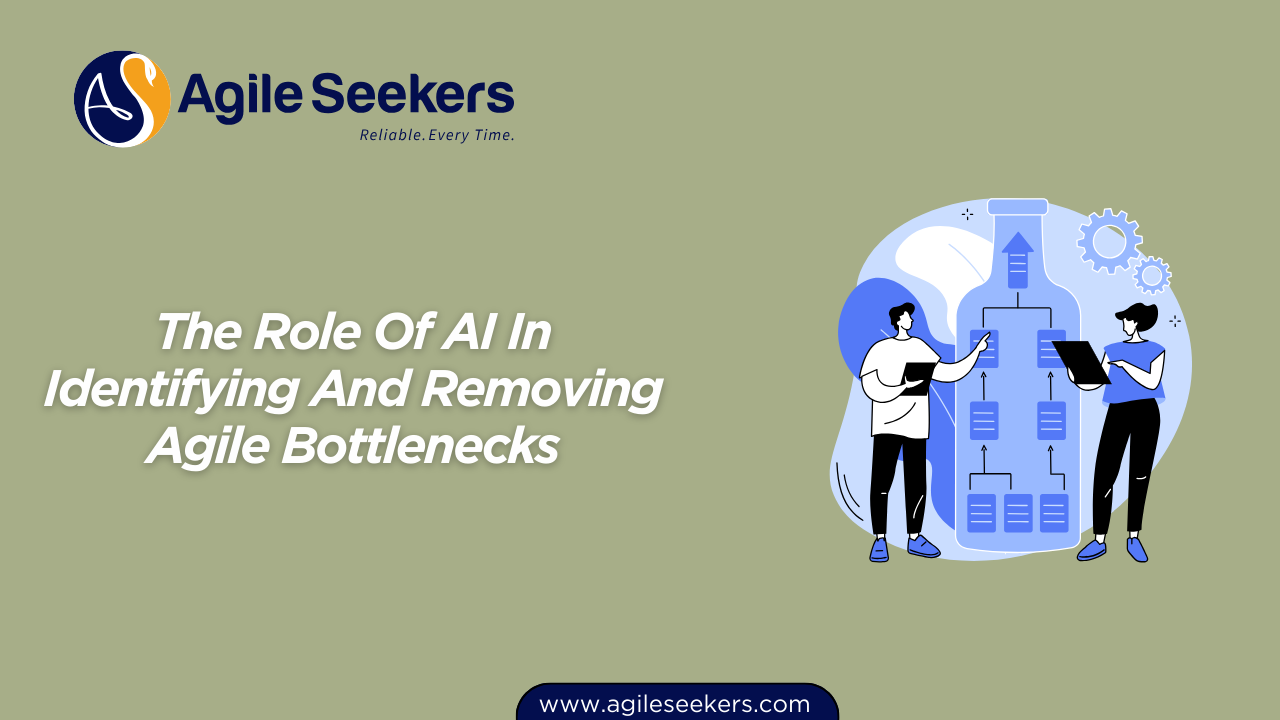The Role Of AI In Identifying And Removing Agile Bottlenecks

Agile promises speed, adaptability, and value delivery. But even the best Agile teams hit roadblocks—dependencies pile up, backlogs swell, testing lags behind, or decision-making slows down. These bottlenecks not only frustrate teams but also stall the flow of value to customers.
Here’s where artificial intelligence becomes more than a support tool—it becomes a game-changer. AI helps leaders, Scrum Masters, Product Owners, and Project Managers spot bottlenecks early, understand their root causes, and design solutions that keep delivery on track.
Why Bottlenecks Matter in Agile
Bottlenecks are points in a workflow where progress slows or stops. In Agile environments, these often appear in:
-
Backlog refinement – too many items, unclear priorities.
-
Development flow – tasks waiting on approvals or resources.
-
Testing and QA – quality checks lagging behind development speed.
-
Cross-team dependencies – one team waiting on another to finish work.
-
Decision-making – product and portfolio choices delayed due to lack of clarity.
Traditional reporting highlights issues after they’ve already hurt timelines. AI flips the script by predicting bottlenecks before they grow into systemic blockers.
How AI Identifies Bottlenecks in Agile Teams
1. Real-Time Data Analysis
AI taps into Jira, Azure DevOps, or Rally and surfaces hidden inefficiencies. Instead of teams manually reviewing charts, AI agents monitor cycle time, lead time, and throughput in real time. A spike in cycle time for a certain task type signals a bottleneck before retrospectives even begin.
2. Pattern Recognition
Bottlenecks rarely appear once; they repeat in cycles. AI models learn from historical sprints and identify recurring blockers like “testing always lags by two days” or “priority changes mid-sprint cause churn.” This turns reactive firefighting into proactive prevention.
3. Dependency Mapping
Agile teams often depend on other squads or external vendors. AI creates visual dependency maps, showing where delays are likely. For example, if Team A delivers late 60% of the time, AI highlights that risk for Team B’s planning.
4. Predictive Forecasting
Instead of relying on best guesses, AI forecasts sprint completion likelihood based on historical velocity and backlog quality. If the system predicts only a 40% chance of completing committed work, leaders can intervene early.
How AI Removes Bottlenecks
1. Automating Repetitive Tasks
Documentation, test case generation, and reporting consume time that could be spent delivering value. AI automates these, freeing up bandwidth for high-value work and reducing queue delays.
2. Intelligent Workload Balancing
Overloaded developers and underutilized testers cause uneven flow. AI redistributes tasks across available capacity. A developer stuck with 10 tasks while another has 2? AI adjusts assignments in real time.
3. Smarter Prioritization
When everything feels urgent, nothing moves. AI evaluates business value, customer demand, and technical dependencies to rank backlog items with objective logic. This ensures high-impact work flows without interruptions.
4. Enhanced Decision Support
Product Owners and managers often struggle with trade-offs. AI dashboards simulate “what if” scenarios—what happens if we cut scope, shift resources, or delay features? This reduces bottlenecks caused by indecision.
Role of Agile Leaders, Project Managers, Product Owners, and Scrum Masters
AI doesn’t replace Agile roles; it augments them. Each role benefits differently:
-
Agile Leaders & Change Agents
AI equips leaders with insights into systemic bottlenecks across the enterprise. With training like AI for Agile Leaders & Change Agents Certification, they learn how to interpret AI-driven metrics and align them with transformation goals. -
Project Managers
For project managers, delays often accumulate from scope creep and unclear dependencies. With AI for Project Managers Certification Training, they gain skills to use predictive analytics and optimize delivery flow. -
Product Owners
Backlog prioritization and dependency conflicts frequently become bottlenecks. AI tools, when paired with AI for Product Owners Certification Training, help Product Owners refine and maintain healthy backlogs. -
Scrum Masters
Scrum Masters thrive on removing blockers. By combining facilitation with AI-powered insights—explored in AI for Scrum Masters Training—they can spot workflow interruptions before teams even raise them in stand-ups.
Practical Examples of AI Removing Bottlenecks
-
QA Bottleneck: AI generates automated test scripts aligned with user stories. This reduces the lag between development and testing, shrinking handoff delays.
-
Backlog Chaos: AI-based backlog grooming tools automatically suggest story splitting and highlight dependencies, helping POs refine faster.
-
Team Churn: AI sentiment analysis on team communication surfaces stress patterns, alerting leaders before burnout slows work.
-
Resource Bottlenecks: AI flags tasks that require scarce skills and recommends pairing strategies or alternative resourcing.
The Broader Impact: Flow, Transparency, and Trust
When bottlenecks disappear, flow improves. Teams move from being reactive to predictive. Transparency increases because AI provides objective insights rather than opinions. Trust grows as leaders no longer rely on gut feel alone—they make decisions backed by data.
External experts like the Project Management Institute highlight how predictive analytics is reshaping project delivery. Similarly, McKinsey’s research on AI in operations emphasizes that AI reduces waste and accelerates time-to-market—two outcomes directly tied to bottleneck removal.
Challenges and Cautions
AI isn’t magic. It requires:
-
Clean data – flawed or incomplete data misguides predictions.
-
Right context – AI should augment, not dictate decisions.
-
Cultural adoption – teams must trust AI insights without fearing micromanagement.
-
Continuous learning – AI models improve over time with feedback loops.
Without these, organizations risk turning AI into yet another bottleneck.
Conclusion
Agile bottlenecks stall delivery, frustrate teams, and slow value realization. AI changes this dynamic by identifying inefficiencies in real time, predicting risks before they escalate, and suggesting corrective actions. It empowers leaders, Scrum Masters, Product Owners, and Project Managers to focus on problem-solving rather than firefighting.
Organizations that combine Agile practices with AI-driven insights don’t just move faster—they move smarter. They create a culture where flow is constant, delivery is reliable, and transformation sticks.
Recommendation: Teams should start small—introduce AI for backlog analysis or cycle time monitoring—then scale gradually.
Also read - AI Powered Approaches To Measuring Transformation Outcomes
Also see - How Leaders Can Use AI To Accelerate Organizational Change




















